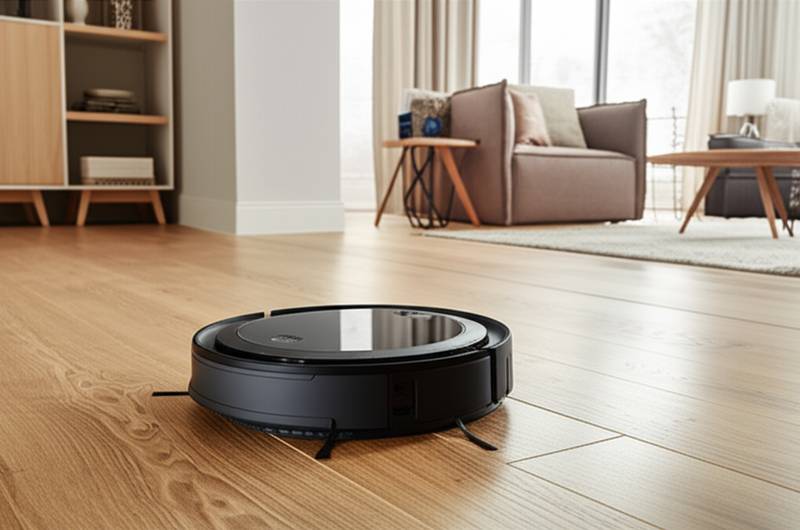When a Robot Vacuum Assumes Housekeeping Duties
Busy households often include pets and floors that accumulate dirt quickly. A standard robot vacuum excels at collecting crumbs and pet hair. However, sticky residues and dull spots persist after such cleaning. Robot vacuum mops address these issues by scrubbing, rinsing, and polishing surfaces with notable accuracy.
These devices liberate hours from weekly chores while maintaining pristine floors. Individuals seeking a gleaming kitchen or a living room prepared for guests find these tools nearly as effective as professional services.
Advancements in Cleaning Technology for Contemporary Residences
Many underestimate the capabilities of current robot vacuum mops. Initial versions primarily combined vacuuming with a moist cloth. Contemporary models automatically elevate over carpets, apply variable pressure during mopping, and launder their own pads. Such enhancements yield superior outcomes, tackling adhesive spills, paw prints, and subtle dust overlooked by conventional vacuums.
The abundance of available options complicates selection. Focus on features aligned with specific home configurations and routines to identify the ideal device.
Mechanisms of Effective Deep Cleaning
Contemporary robot vacuum mops surpass mere water distribution. They integrate suction, agitation, and navigation intelligence to achieve manual deep-clean standards.
The typical process unfolds as follows:
-
Accurate Mapping: LiDAR or camera-based systems generate a digital floor plan. This enables optimized paths and comprehensive coverage, including edges.
-
Adaptive Suction: Advanced units modulate power when transitioning between hard surfaces and rugs. This maximizes debris extraction while conserving energy.
-
Dynamic Agitation: Certain models exert controlled downward force or vibrate mop pads to replicate manual scrubbing.
-
Pad Maintenance: High-end variants rinse pads mid-operation and facilitate drying to inhibit bacterial growth.
-
Customized Zones: Applications permit designation of mop-free areas for rugs or busy zones, ensuring seamless automation.
For optimal outcomes, utilize warm water in the reservoir. This accelerates grime dissolution on sealed wood or tile surfaces.
Selections Across Price Ranges
The robot vacuum mop sector has grown swiftly, offering choices for various budgets. The following recommendations span entry-level to luxury categories.
Budget Option: Eufy RoboVac X10 Pro Omni (Approximately $500)
This efficient device vacuums and mops simultaneously. Rotating pads, an auto-emptying bin, and reliable routing suit its cost. Although it omits self-washing for pads, it performs reliably in compact spaces like apartments.
Mid-Range Selection: Roborock Q Revo (Approximately $900)
The Roborock Q Revo balances efficacy and ease. Dual spinning pads, 5500 Pa suction, and a station for washing and drying pads define its strengths. Rapid floor plan acquisition supports room-specific scheduling via the app.
Luxury Choice: Ecovacs Deebot X2 Omni (Approximately $1,400)
Designed for comprehensive automation, this square-shaped unit accesses corners effectively. A 15 mm pad elevation avoids carpet wetting, while the base handles washing, drying, and refilling. App integration extends to voice commands through Alexa or Google Assistant.
Compatibility with smart home systems varies; confirm alignment with existing setups prior to purchase.
Essential Considerations for Purchase
Floor Composition and Configuration
These robots thrive on hard surfaces such as tile, laminate, or vinyl. In mixed environments with carpets and wood, prioritize models with automatic pad lifting to safeguard textiles from moisture.
Docking Station Positioning
Allocate space for the base, particularly for self-maintenance features. Allow two feet laterally and four feet forward for unobstructed access.
Upkeep and Replacement Parts
Self-cleaning units still require periodic attention. Replace pads and filters every three to six months at $20 to $40 per set. Maintain spares to minimize interruptions.
Wireless Integration and Application Management
Wi-Fi connectivity enables remote operation and timetabling. Voice activation through assistants like Alexa enhances usability. For data privacy, seek units with local control options.
Runtime and Sound Output
Premium models sustain 150 to 200 minutes per charge. Operation hovers at 60 decibels in standard mode, akin to conversation volume, though intense suction elevates noise.
Achieving Expert Cleaning Standards
The choice of cleaning agent significantly influences results. Distilled water suffices for minor dust, yet a diluted neutral solution enhances luster and minimizes residue. Consult the manual for compatibility.
Initiate with a dry vacuum pass before mopping to eliminate loose particles that might abrade floors. Configure the app to sequence these steps automatically for efficiency.
Investment and Implementation Overview
Setup requires minimal effort; operational readiness follows unboxing within one hour. Primary expenses encompass the device and occasional supplies:
- Entry-level: $400 to $600
- Intermediate: $800 to $1,000
- Advanced: $1,200 to $1,600
Bases accompany purchases, with add-ons like solutions incurring slight recurring fees. For smart home incorporation, explore vetted services via xavagetech.com Marketplace.
Sustaining Peak Robot Functionality
Regular dustbin emptying and pad rinsing after intensive sessions preserve performance. Inspect sensors weekly and clean charging points. Automated drying in modern bases deters mold.
Address navigation lapses by remapping or polishing the LiDAR lens. A system reboot frequently reinstates accuracy.
Frequently Asked Questions
What distinguishes a robot vacuum mop from a standard vacuum?
Robot vacuum mops incorporate wet cleaning mechanisms, including pads and water reservoirs, to scrub and polish alongside dry debris removal.
Do these devices work on all floor types?
They excel on hard surfaces but require mop-lifting features for carpeted areas to prevent dampness.
How often should I replace mop pads?
Every three to six months, depending on usage frequency and floor conditions.
Can I control the robot without an app?
Most models support basic manual operation, though apps unlock scheduling and zoning.
What if the robot avoids certain areas?
Clean sensors, update maps, or adjust boundaries in the app to resolve coverage issues.
Embracing Effortless Floor Maintenance
Autonomous cleaning establishes a new standard for home care. The subtle operation integrates seamlessly into daily life. Select a model suited to your needs to secure enduring cleanliness and reclaim valuable time.
